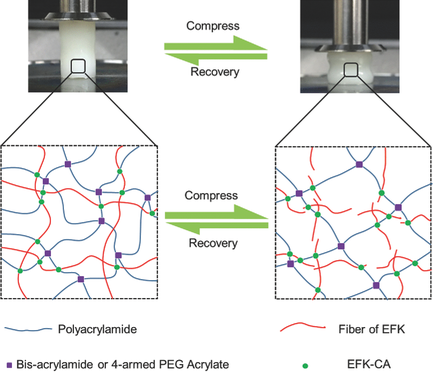当前位置:
X-MOL 学术
›
Adv. Funct. Mater.
›
论文详情
Our official English website, www.x-mol.net, welcomes your
feedback! (Note: you will need to create a separate account there.)
Polymer‐Supramolecular Polymer Double‐Network Hydrogel
Advanced Functional Materials ( IF 18.5 ) Pub Date : 2016-10-21 , DOI: 10.1002/adfm.201603512 Wenxu Sun 1 , Bin Xue 1 , Ying Li 1, 2 , Meng Qin 1 , Junyi Wu 3 , Ke Lu 3 , Junhua Wu 3 , Yi Cao 1 , Qing Jiang 3 , Wei Wang 1
Advanced Functional Materials ( IF 18.5 ) Pub Date : 2016-10-21 , DOI: 10.1002/adfm.201603512 Wenxu Sun 1 , Bin Xue 1 , Ying Li 1, 2 , Meng Qin 1 , Junyi Wu 3 , Ke Lu 3 , Junhua Wu 3 , Yi Cao 1 , Qing Jiang 3 , Wei Wang 1
Affiliation

|
Mechanical properties of hydrogels are critical for their applications as articular cartilage regeneration scaffolds, because they provide not only the mechanical support, but also the mechanical cues essential to maintain the phenotype of cartilage‐forming cells. Inspired by the microscopic architecture of natural cartilage, here the engineering of a novel double‐network hydrogel with interconnected polymer‐supramolecular polymer double‐network (PS‐DN gel) for cartilage regeneration is reported. The polymer network is made of polyacrylamide and the supramolecular polymer network comprises of a kind of self‐assembled peptide fibers. Upon mechanical loading, the peptide fibers serve as sacrificial bonds to efficiently dissipate energy. They can quickly reform when mechanical load is released thanks to the fast and accurate peptide self‐assembly. These entail the PS‐DN gel of high mechanical strength of ≈0.32–0.57 MPa, fracture energy of ≈300–2670 J m−2, compressibility of ≈66%–90%, and fast recovery in seconds. The gel also shows significant energy dissipation, strain stiffening, and stress relaxation behaviors similar to articular cartilage. Moreover, the mechanical properties of the PS‐DN gel can be tailored by adjusting the chemical components of the gel. Therefore, this novel biomaterial represents a promising candidate for the regeneration of cartilage and other load bearing tissues.
中文翻译:

聚合物-超分子聚合物双网络水凝胶
水凝胶的机械特性对其作为关节软骨再生支架的应用至关重要,因为水凝胶不仅提供机械支持,而且还提供维持软骨形成细胞表型必不可少的机械提示。受天然软骨微观结构的启发,这里报道了一种新型双网络水凝胶的工程设计,该网络具有相互连接的聚合物-超分子聚合物双网络(PS-DN凝胶)用于软骨再生。聚合物网络由聚丙烯酰胺组成,超分子聚合物网络由一种自组装肽纤维组成。在机械加载时,肽纤维充当牺牲键以有效地耗散能量。凭借快速准确的多肽自组装功能,当释放机械负荷时,它们可以快速进行改造。−2,可压缩性约为66%–90%,可在几秒钟内快速恢复。该凝胶还显示出显着的能量耗散,应变变硬和类似于关节软骨的应力松弛行为。此外,可以通过调整凝胶的化学成分来调整PS‐DN凝胶的机械性能。因此,这种新型生物材料代表了软骨和其他承重组织再生的有希望的候选者。
更新日期:2016-10-21
中文翻译:

聚合物-超分子聚合物双网络水凝胶
水凝胶的机械特性对其作为关节软骨再生支架的应用至关重要,因为水凝胶不仅提供机械支持,而且还提供维持软骨形成细胞表型必不可少的机械提示。受天然软骨微观结构的启发,这里报道了一种新型双网络水凝胶的工程设计,该网络具有相互连接的聚合物-超分子聚合物双网络(PS-DN凝胶)用于软骨再生。聚合物网络由聚丙烯酰胺组成,超分子聚合物网络由一种自组装肽纤维组成。在机械加载时,肽纤维充当牺牲键以有效地耗散能量。凭借快速准确的多肽自组装功能,当释放机械负荷时,它们可以快速进行改造。−2,可压缩性约为66%–90%,可在几秒钟内快速恢复。该凝胶还显示出显着的能量耗散,应变变硬和类似于关节软骨的应力松弛行为。此外,可以通过调整凝胶的化学成分来调整PS‐DN凝胶的机械性能。因此,这种新型生物材料代表了软骨和其他承重组织再生的有希望的候选者。


















































 京公网安备 11010802027423号
京公网安备 11010802027423号